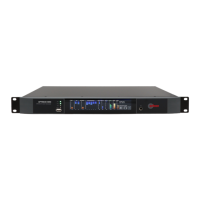2-6Installation
Lack of transparency in the path will cause overshoot. Unless carefully designed, dual microwave STLs can
introduce non-constant group delay in the audio spectrum, distorting peak levels when used to pass processed
audio. Nevertheless, in a system using a microwave STL, the 5950 is sometimes located at the studio and any
overshoots induced by the link are tolerated or removed by the transmitter’s protection limiter (if any). The 5950
can only be located at the transmitter if the signal-to-noise ratio of the STL is good enough to pass unprocessed
audio. The signal-to-noise ratio of the STL can be used optimally if an Orban OPTIMOD-PC 1101 or OPTIMOD 6300
protect the link from overload. These are the preferred choices because their AGCs are identical to the AGC in the
5950.
Some microwave links can be modified so that the deviation from linear phase is less than +10
from 20Hz to
15kHz and frequency response is less than 3dB down at 0.15Hz and less than 0.1dB down at 20kHz. This
specification results in less than 1% overshoot with processed audio. Many such links have been designed to be
easily configured at the factory for composite operation, where an entire FM stereo baseband is passed. The
requirements for maintaining stereo separation in composite operation are similar to the requirements for high
waveform fidelity with low overshoot. Therefore, most links have the potential for excellent waveform fidelity if
they are configured for composite operation (even if a composite FM stereo signal is not actually being applied to
the link).
Nevertheless, in a dual-microwave system, the 5950 is usually located at the main FM transmitter and is driven by
the microwave receivers. One of Orban’s studio level control systems, such as the OPTIMOD 6300, protects the
microwave transmitters at the studio from overload. These units also perform the gain riding function ordinarily
executed by the AGC section of the 5950’s processing and optimize the signal-to-noise ratio obtainable from the
dual-microwave link.
Analog Landline (PTT / Post Office Line): Analog landline quality is extremely variable, ranging from excellent to
poor. Whether landlines should be used or not depends upon the quality of the lines locally available and upon the
availability of other alternatives. Due to line equalizer characteristics and phase shifts, even the best landlines tend
to veil audio quality slightly. They will certainly be the weakest link in a FM broadcast chain. Slight frequency
response irregularities and non-constant group delay characteristics will alter the peak-to-average ratio and will
thus reduce the effectiveness of any peak limiting performed prior to their inputs.
STL and Exciter Overshoot
Earlier in this section, we discussed at length what is required to prevent STLs from overshooting. There are similar
requirements for FM exciters. Nevertheless, in some installations some overshoot is inevitable. If this is a problem
in your installation, the 5950’s remote control feature offers the means to reduce the peak level of the 5950’s
audio output as necessary.
This way, you can still use the 5950’s line-up tone to adjust the steady-state deviation to 75kHz. Yet, the reduced
peak level of the audio emitted from the 5950 ensures that the carrier deviates no further than 75 kHz after
overshoot. This overshoot reduction can be selected on the INPUT/OUTPUT screen and the remote operation can
be selected in SYSTEM SETUP > NETWORK / REMOTE.

